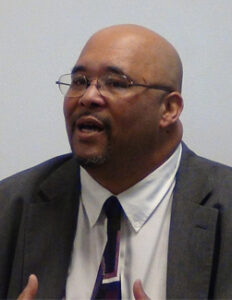By Dr. Ede Warner

Dr. Ede Warner
Teaching Veterans to Create and Project a Personal Brand Through Speech
Any audience starts with three assumptions or questions when someone speaks in any setting about any topic. The listener wants to know: Why is this person speaking about this topic; why are they qualified to speak on it; and finally can this person say anything to change what I already think or know about the topic?
Over the last three years, no matter the subject of my courses, they all start the same way. Think of it as building different types of houses—they all start with the same foundation.
A student’s first assignment is called the inventory speech. They are asked to write four paragraphs, the first three starting with the words “I am” and the fourth starting with the words “I am not.” The second assignment is called the “asset” speech. After reflecting on their inventory, students must construct an “asset” either from one or more of their “I am’s” or from some aspect of their identity they omitted.
They are encouraged to be creative. Your asset should be something that defines you, that you feel you are successful at, and that you have had a lot of experiences with that you can talk about. No matter what the content or assignment may be for the rest of the course, students will be required to use their asset in some way. Why? Because the student has identified a personal strength from of a series of characteristics that define them, and it becomes an anchor for their “speech.” In technical terms, it becomes the foundation for the type of house he or she wants to build.
In public speaking and persuasion, this foundation is a person’s ethos. Influencing others is a process that starts with ethos—the place where one finds his or her passion, knowledge, interest, etc. Only when the ethos is found and cultivated, can one produce other types of Aristotelian appeals—emotional and logical—in ways that can influence audiences.
When we think, speak, and act, we have a set of personal experiences that we are uniquely qualified to talk about, relate other ideas to, and guide our personal decision making. Our experiences have the potential to “brand” us in the communication process. So in my classes, students are invited to first define, then “invest” in their asset, in the same way a business invests in people, ideas, or materials.
Investing in National Assets
Of the hundreds of assets students have selected, a unique amount of data has been cultivated. Some assets are completely unique: a linguistic dreamer, a world traveler, a story addict, or a wild child. Other assets are more common and personal: a parent, a child, a sibling, a student, a gamer, or a dedicated or hard worker. A third category of assets are intimate and powerful levels of self-disclosure: cancer survivor; organ donation recipient; or domestic abuse survivor.
Many of my students define themselves by a common experience: their military experience. I call these veterans the “national” asset of my classes. They are usually older, nontraditional students who don’t fall into the statistical 75% of Americans that are apprehensive about speaking in public. Generally, they are comfortable, disciplined, organized, and well-respected by their younger peers and classmates. In other words, in a class that teaches leadership through speech, they often provide a strong student example that visualizes what a comfortable student speaker looks like, while growing in class like other students by learning the technical aspects of more formal speech.
While their experiences vary, the topics chosen by this select group are often eye-opening. While they certainly have given speeches on the more run-of-the-mill topics, I’ve heard speeches about things like Post Traumatic Stress Disorder; administrative issues at the Veterans Administration; respect for cultural difference; and hungry, homeless, and unemployed veterans. While there may be nothing surprising about that, the credibility of each of these speakers is amazing.
One veteran student, Nathan Davis, exhibited some of the strongest leadership skills I could imagine. His relatability to a group of classmates almost twenty years younger was outstanding. In fact, one day, I asked the students to have a conversation about the class, asked Davis to facilitate the conversation, turned on a video camera, and left the room. Not only did Davis explain the value of the asset in terms that were more powerful than any I had used (using the example of everyone in class giving a speech about celery), but he unknowingly persuaded one student to give an impassioned off-the-cuff speech about her personal experiences.
Until that moment she had been reluctant to share her personal experiences as part of the speech assignment, simply accepting the reduction of points for that portion of the grading. But attributing a comfort and understanding to his earlier words, she chose to convey the evolution of her public speaking fears and triumphs in a powerful way, as it related to a volunteerism trip to Africa just after high school.
What brings credibility to a speaker and a leader is his or her unique life experiences. That identity has the potential to shed new light on the facts, and bring a unique context that helps create a solution to any problem given.
Dr. Ede Warner, Jr. is president and principal of Greater Decisions Consulting LLC. His identity-based communication model increases personal comfort and personal connection with others, and provides a better test of ideas and evidence.






